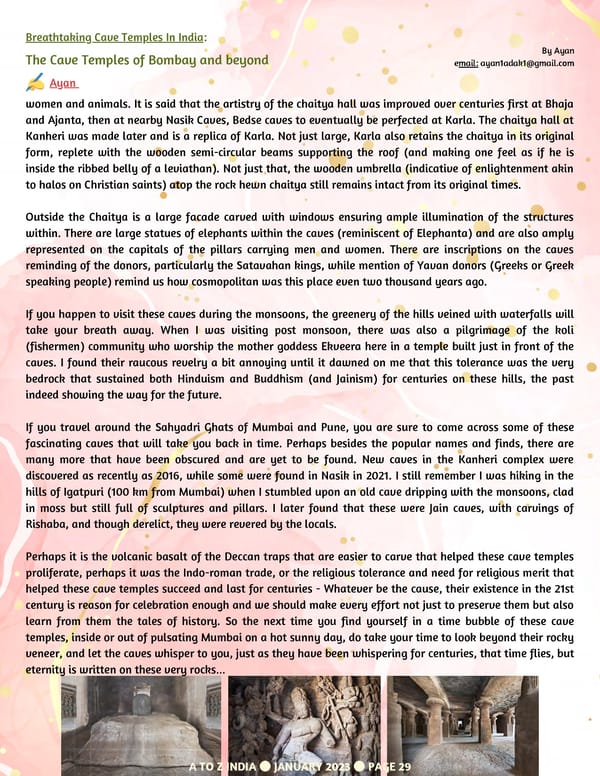Breathtaking Cave Temples In India: By Ayan The Cave Temples of Bombay and beyond email: [email protected] Ayan women and animals. It is said that the artistry of the chaitya hall was improved over centuries first at Bhaja and Ajanta, then at nearby Nasik Caves, Bedse caves to eventually be perfected at Karla. The chaitya hall at Kanheri was made later and is a replica of Karla. Not just large, Karla also retains the chaitya in its original form, replete with the wooden semi-circular beams supporting the roof (and making one feel as if he is inside the ribbed belly of a leviathan). Not just that, the wooden umbrella (indicative of enlightenment akin to halos on Christian saints) atop the rock hewn chaitya still remains intact from its original times. Outside the Chaitya is a large facade carved with windows ensuring ample illumination of the structures within. There are large statues of elephants within the caves (reminiscent of Elephanta) and are also amply represented on the capitals of the pillars carrying men and women. There are inscriptions on the caves reminding of the donors, particularly the Satavahan kings, while mention of Yavan donors (Greeks or Greek speaking people) remind us how cosmopolitan was this place even two thousand years ago. If you happen to visit these caves during the monsoons, the greenery of the hills veined with waterfalls will take your breath away. When I was visiting post monsoon, there was also a pilgrimage of the koli (fishermen) community who worship the mother goddess Ekveera here in a temple built just in front of the caves. I found their raucous revelry a bit annoying until it dawned on me that this tolerance was the very bedrock that sustained both Hinduism and Buddhism (and Jainism) for centuries on these hills, the past indeed showing the way for the future. If you travel around the Sahyadri Ghats of Mumbai and Pune, you are sure to come across some of these fascinating caves that will take you back in time. Perhaps besides the popular names and finds, there are many more that have been obscured and are yet to be found. New caves in the Kanheri complex were discovered as recently as 2016, while some were found in Nasik in 2021. I still remember I was hiking in the hills of Igatpuri (100 km from Mumbai) when I stumbled upon an old cave dripping with the monsoons, clad in moss but still full of sculptures and pillars. I later found that these were Jain caves, with carvings of Rishaba, and though derelict, they were revered by the locals. Perhaps it is the volcanic basalt of the Deccan traps that are easier to carve that helped these cave temples proliferate, perhaps it was the Indo-roman trade, or the religious tolerance and need for religious merit that helped these cave temples succeed and last for centuries - Whatever be the cause, their existence in the 21st century is reason for celebration enough and we should make every effort not just to preserve them but also learn from them the tales of history. So the next time you find yourself in a time bubble of these cave temples, inside or out of pulsating Mumbai on a hot sunny day, do take your time to look beyond their rocky veneer, and let the caves whisper to you, just as they have been whispering for centuries, that time flies, but eternity is written on these very rocks… A TO Z INDIA ● JANUARY 2023 ● PAGE 29
 A TO Z INDIA - JANUARY 2023 Page 28 Page 30
A TO Z INDIA - JANUARY 2023 Page 28 Page 30